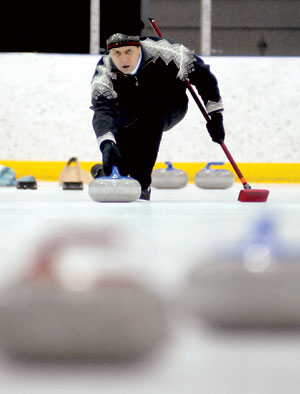WHITEFISH – Late on a recent Friday night in Whitefish, when most people were either sleeping or celebrating the end of the week at a downtown bar, the Stumptown Ice Den was hosting a curling tournament.
The Whitefish Curling Club wrapped up its winter league season on March 18, with 12 teams trying to secure top spots in the final standings. Despite the inherently competitive nature of a league, curling tournaments maintain a general atmosphere of camaraderie. Curlers seem to get along. It’s part of the sport.
 |
|
Erik Ill glides across the ice and gently pushes a polished granite stone, or “rock,” toward a target during a curling league game at Stumptown Ice Den in Whitefish. |
“Curlers are just the nicest people,” Tim Joern, president of the Whitefish Curling Club, said. “Everyone helps each other and congratulates each other.”
Since forming in 2009, the Whitefish Curling Club has grown to almost 70 members. There were 12 teams in this year’s winter league, four more than last year. The club has managed to achieve this rapid growth despite its late-night weekend schedule, which is the only available ice time at the popular Stumptown Ice Den. Tournaments are held between 10 p.m. and about 1 a.m. on Fridays.
“Once you’re here, you start having fun and you don’t really notice it’s that late,” Joern said last week while waiting for his team’s turn to compete at the tournament.
He added: “Our curling time is a limiting factor. If we had better times, it would be crazy. It’s the only indoor rink in the valley. The rink has done a great job of trying to accommodate everyone.”
Most of the Whitefish Curling Club members had never curled before attending one of the club’s “Learn-to-Curl” tutorials, held throughout the year and open to the public. There is a “Learn-to-Curl” event on March 24 at the Stumptown Ice Den from 6 p.m. to 9 p.m. All ages are invited for a fee of $10.
Upon hearing about curling, Joern, an eighth-grade science teacher at Whitefish Middle School, decided the sport might be for him. The game offers lesson in friction and Isaac Newton theories, among other concepts that excite a middle-school science teacher.
“I thought, ‘That’s so nerdy it’s cool,’” he said. “It’s been fun watching it grow.”
Americans generally are familiar with curling only through the Winter Olympics, where it is recognized as an official sport. The sport is akin to a giant game of shuffleboard played on ice with four-person teams.
One player sends a heavy granite “stone” down a marked-off rectangular playing area called a “sheet.” At the end of the sheet is a set of concentric circles – essentially a large bulls-eye. Two sweepers move alongside the stone, scrubbing the ice with brooms to alter the speed and path of the stone as necessary.
The fourth player stands near the bulls-eye, communicating with the sweepers in an effort to get the stone as close to the middle of the bulls-eye as possible.
“Communication is huge,” Joern said.
Club member Jake How said curling has caught on in part because it’s “kind of exotic.” In the Flathead Valley, How said people are eager to try offbeat sports. And once you try curling, How said, you don’t want to give it up. There is also a curling club in Missoula, which is growing at a similarly rapid rate.
“Curling is pretty neat,” How said. “I just love it. I love the sport. There’s a lot of color and it’s just so fun. Even late at night we have 12 teams.”
 |
|
Players navigate heavy, polished granite stones – called “rocks” – during a recent night of Whitefish Curling Club games at Stumptown Ice Den. Players take turns sliding the rocks across the ice toward the “house,” a circular target marked on the ice. |
Joern said stones are made from granite found only in a certain region in the British Isles. New, they cost between $8,000 and $12,000. Used, they’re still about half of that. Joern said the granite is so specialized because it has to have a specific density and can’t absorb water. Each stone weighs over 40 pounds. Donations and membership fees contribute to purchasing the stones.
“We also have sponsors who have adopted stones,” Joern said. “That’s helped us acquire stones to a large extent.”
How said people of all ages and interests will find curling appealing.
“The ultimate goal is to increase visibility and increase the number of people who want to curl,” How said. “It’s an adventure.”
For more information on the Whitefish Curling Club and the March 24 “Learn-to-Curl” event, visit www.whitefishcurlingclub.com or e-mail Tim Joern at [email protected].